
Heidelberg is a city in the German state of Baden-Württemberg, situated on the river Neckar in south-west Germany. As of the 2016 census, its population was 159,914, of which roughly a quarter consisted of students.
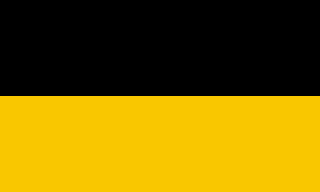
Baden-Württemberg, commonly shortened to BW or BaWü, is a German state in Southwest Germany, east of the Rhine, which forms the southern part of Germany's western border with France. With more than 11.07 million inhabitants as of 2019 across a total area of nearly 35,752 km2 (13,804 sq mi), it is the third-largest German state by both area and population. As a federated state, Baden-Württemberg is a partly-sovereign parliamentary republic. The largest city in Baden-Württemberg is the state capital of Stuttgart, followed by Mannheim and Karlsruhe. Other major cities are Freiburg im Breisgau, Heidelberg, Heilbronn, Pforzheim, Reutlingen, Tübingen, and Ulm.
Viracocha is the great creator deity in the pre-Inca and Inca mythology in the Andes region of South America. According to the myth Viracocha had human appearance and was generally considered as bearded. According to the myth he ordered the construction of Tiwanaku. It is also said that he was accompanied by men also referred to as Viracochas.

Mannheim, officially the University City of Mannheim, is the second-largest city in the German state of Baden-Württemberg, after the state capital of Stuttgart, and Germany's 21st-largest city, with a 2021 population of 311,831 inhabitants. The city is the cultural and economic centre of the Rhine-Neckar Metropolitan Region, Germany's seventh-largest metropolitan region with nearly 2.4 million inhabitants and over 900,000 employees.

Wiesloch is a town in northern Baden-Württemberg, Germany. It is situated 13 kilometres south of Heidelberg. After Weinheim, Sinsheim and Leimen, it is the fourth largest town in the Rhein-Neckar-Kreis. It shares Wiesloch-Walldorf station with its neighbouring town Walldorf. Also in the vicinity of Wiesloch are Dielheim, Malsch, Mühlhausen, Rauenberg and Sankt Leon-Rot.
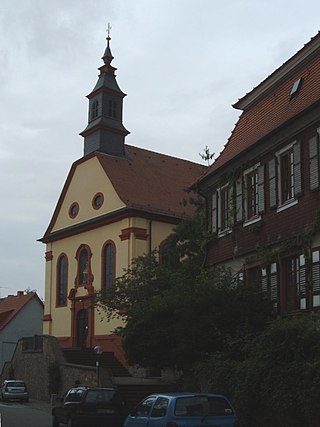
Hemsbach is a town with approximately 12,000 inhabitants in the Rhein-Neckar-Kreis of Baden-Württemberg, Germany. It belongs to the European Rhine-Neckar Metropolitan Region. It is situated on the Bergstraße, 18 km northeast of Mannheim. Hemsbach was twinned with Wareham, Dorset in the UK in 1986.

Karlsruhe Hauptbahnhof is a railway station in the German city of Karlsruhe. The station is classified as a Category 1 station, as it is a major hub where several railways connect.
The Rhine-Neckar S-Bahn(S-Bahn RheinNeckar) forms the backbone of the urban rail transport network of the Rhine Neckar Area, including the cities of Mannheim, Heidelberg and Ludwigshafen.
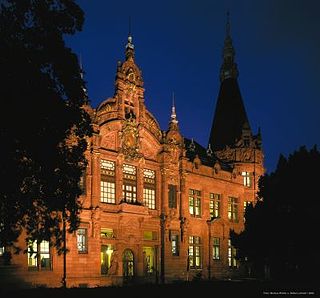
The Heidelberg University Library is the central library of the Heidelberg University. Together with the 83 decentralized libraries of the faculties and institutes, it forms the University Library System, which is headed by the director of the University Library. The University Library holds special collections in literature concerning the Palatinate and Baden, egyptology, archeology, the history of art, and South Asia. It holds about 3.2 million books, 6,000 printed scientific periodicals, and about 500,000 other media such as microfilms and video tapes. The libraries of the faculties and institutes hold another 3 million printed books. In 2022, the University Library registered 43,600 active users who accessed more than 746,000 books. The conventional book supply is complemented by numerous electronic services, including approximately 152,00 electronic journals. The University Library provides around 1,100 reading- and workspaces in the main library in the old town and around 320 reading- and workspaces in the branch in the Neuenheimer Feld, including many IT-workstations and research stations equipped with PCs.

The Rhine Railway is a railway line in the German state of Baden-Württemberg, running from Mannheim via Karlsruhe to Rastatt, partly built as a strategic railway and formerly continuing to Haguenau in Alsace, now in France.

The Hardt Railway is a railway line in the Karlsruhe region of Germany. Originally built as part of the Rhine Railway, a through main line, it now forms a branch line from Karlsruhe to Hochstetten. The line runs along the western edge of the forest of Hardtwald, from which it takes its name.
Riet is a village in the town of Vaihingen an der Enz, Germany. The population is around 900, and it is about 5 kilometres (3.1 mi) south of central Vaihingen.

The Winden–Karlsruhe railway is a mainline railway in the German states of Baden-Württemberg and Rhineland-Palatinate, which in its present form has existed since 1938 and is electrified between Wörth and Karlsruhe. The current Winden–Wörth section was opened in 1864. A year later, the gap between the Rhine and the Maxau Railway (Maxaubahn), which had been opened in 1862, was closed. The route of the latter was changed during the relocation of the Karlsruhe Hauptbahnhof. New sections of the line were also built between Wörth and Mühlburg mainly in connection with the commissioning of a fixed bridge over the Rhine.

Wörth (Rhein) station—originally Wörth (Pfalz)—is the most important station of the town of Wörth am Rhein in the German state of Rhineland-Palatinate. Deutsche Bahn classifies it as a category 5 station and it has five platforms. The station is located in the area of the Karlsruher Verkehrsverbund and it belongs to fare zone 540. Since 2001, Verkehrsverbund Rhein-Neckar (VRN) tickets are also accepted for travel to or from the VRN area. The address of the station is Bahnhofstraße 44.
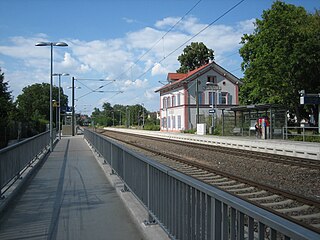
Sondernheim station is a station in the Germersheim suburb of Sondernheim, in the German state of Rhineland-Palatinate. Deutsche Bahn classifies it as a category 6 station and it has two platform tracks. The station is located in the network of the Karlsruher Verkehrsverbund and belongs to fare zone 575. Since 2001, the station has also been part of the area where the fares of the Verkehrsverbund Rhein-Neckar are accepted at a transitional rate. The address of the station is Germersheimer Straße 14. Its former entrance building is under heritage protection.

Bellheim station is a station in the village of Bellheim in the German state of Rhineland-Palatinate. Deutsche Bahn classifies it as a category 6 station and it has two platform tracks. The station is located in the network of the Karlsruher Verkehrsverbund. Since 2001, the station has also been part of the area where the fares of the Verkehrsverbund Rhein-Neckar are accepted at a transitional rate. The address of the station is Bahnhofstraße 8.

Rülzheim station is a station in the town of Rülzheim in the German state of Rhineland-Palatinate. The original station was opened on 25 July 1876 with the commissioning of the Germersheim–Wörth section of Schifferstadt–Wörth railway. The address of the old entrance building, which is heritage listed, is Bahnhofstraße 6.

Rheinzabern station is the main station in the town of Rheinzabern in the German state of Rhineland-Palatinate. Deutsche Bahn classifies it as a category 6 station and it has two platform tracks. It is located on the network of the Karlsruher Verkehrsverbund. Since 2001, the station has also been part of the area where the fares of the Verkehrsverbund Rhein-Neckar are accepted at a transitional rate. Its address is Bahnhofstraße 26.
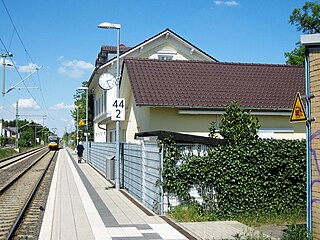
Jockgrim station is the only station in the town of Jockgrim in the German state of Rhineland-Palatinate. Deutsche Bahn classifies it as a category 6 station and it has two platform tracks. It is located on the network of the Karlsruher Verkehrsverbund and belongs to fare zone 555. Since 2001, the station has also been part of the area where the fares of the Verkehrsverbund Rhein-Neckar are accepted at a transitional rate. Its address is Am Bahnhof 1.

Melchingen is a Swabian village in the district of Zollernalbkreis, Baden-Württemberg, Germany. It is 730 m above sea level and has 895 inhabitants. Melchingen is known for its annual pottery and handicraft market, and the Theater Lindenhof, founded in 1981.





















